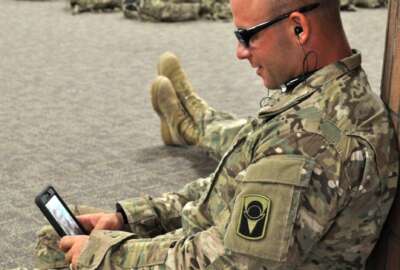BYOD, app consolidation next for Army digital transformation
Raj Iyer, the Army’s chief information officer, said 20,000 soldiers and civilians will be among the first to use the new bring-your-own-device technology.
CAMBRIDGE, Md. — The Army’s digital transformation strategy was initially about getting the service to a unity of vision.
Seven months after releasing the strategy, it’s delivering new capabilities to warfighters.
Raj Iyer, the Army’s chief information officer, said the three separate implementation plans around cloud, data and unifying the network are all bearing fruit to improve warfighter effectiveness and capabilities.

“These three efforts are now being tracked with quantifiable metrics and milestones to see what progress we’re making. I’m happy to report good progress are all around and all three efforts,” Iyer said after his speech at the ACT-IAC Emerging Technology and Innovation Conference. “We’re probably, in my opinion, about halfway there with the goals that we set out …”
One of the foundational elements of the Army’s digital transformation effort is the move to Microsoft Office 365.
Iyer said almost a million soldiers and civilians moved into the Office 365 environment, which includes email, Teams and other collaboration capabilities.
“I think where we’re headed now is really moving into SharePoint online. That will enable us to sunset probably about 200-plus instances of SharePoint across the Army,” he said. “That is just a foundation because we are now looking at how we can leverage tools like Power BI and Power Apps that come with the O365 environment. We’re integrating video conferencing into our conference rooms, leveraging O365 so that way we can divest off of some of the old video teleconferencing (VTC) equipment that we have on our conference rooms. We’re integrating voice capability into O365 so you get a number that goes with your O365 accounts.”
Many of these capabilities will come to the Army a little at a time. Iyer said the service is using an agile development approach, starting many times with the National Guard and Reserve.
“We felt was the National Guard and Reserve didn’t have the right technologies in place to be able to work in a remote work environment. Before COVID they were able to go to an armory or to a reserve center to be able to check emails and do certain things. Post COVID, it became much harder for them to actually go to an office location to do things. So we’re really focusing on improving the user experience for our reserve and guard,” he said. “Every one of these efforts, whether it’s bring-your-own-device (BYOD), or whether it’s virtual desktop infrastructure, we’re starting with National Guard and Reserve first, and essentially, that will be the first rollout. We start to roll it out across other parts of the Army over the next 12-to-18 months when you’re going to see all of these initiatives fully implemented across the Army.”
Iyer is especially excited about the BYOD initiative.
After a successful pilot with the National Guard and Reserve in 2021, Iyer said he is ready to implement the BYOD technology to about 20,000 users this year — 10,000 in the guard and reserve and 10,000 across the rest of the Army.
“We’re trying to make this as global as we can to start with because you want a good idea as to you know how well it works across a broad cross section of our users around the world,” he said. “We are just finishing out some of the early testing. I expect to start onboarding users probably in the next 60 days or so.”
The challenge for the Army was finding the right technology that would be secure enough, but also respect the privacy of soldiers and civilians.
Iyer said through a service-disabled veteran-owned small business, the Army is using a BYOD technology that can work securely on “unmanaged” devices.
“We found a company that were in the early stages of prototyping, but they had an implementation at Special Operations Command (SOCOM). It was, however, in a much smaller, narrower context than what the Army wants to do at scale,” he said. “But we worked with the vendor to get them through the cybersecurity processes and we made sure that we did a full vulnerability testing, pen testing on it. It came back with flying colors and so we’re now on a path to get that implemented across the Army.”
Copyright © 2024 Federal News Network. All rights reserved. This website is not intended for users located within the European Economic Area.
Jason Miller is executive editor of Federal News Network and directs news coverage on the people, policy and programs of the federal government.
Follow @jmillerWFED





